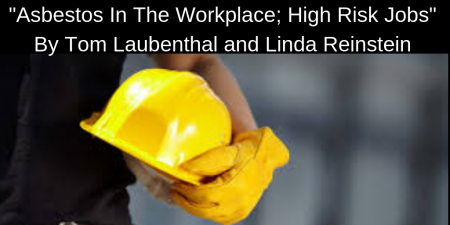Cross-Posted EIA: Asbestos In The Workplace; High Risk Jobs By Tom Laubenthal and Linda Reinstein
Posted on October 31, 2018
In the asbestos control community, we’ve just had major flurry of activity with our ongoing efforts to get a ban on asbestos use in the US. While the Environmental Protection Agency (EPA) may not choose to go in that direction, again, trying to ban further use of asbestos in construction is a worthwhile investment in the future. With that being said, we currently have an untold amount of asbestos in our workplaces from legacy use, and those that can be installed legally today. We must also keep our attention on the workplaces where many of our workers can still be at high risk for long term occupational exposures and risk for asbestos disease.
There are occupations in the US with a high-risk of asbestos exposure that we often describe including, but are not limited to, the following:
Workers involved in the manufacture or installation of asbestos products.
Construction trades involved in the maintenance of existing systems where asbestos con be present including; boilermakers, insulators, sheet metal workers, electricians, plumbers, pipe fitters, carpenters and laborers.
Workers in a variety of occupations within industrial environments of all kinds where large quantities of asbestos can be found such as: power generation plants, refineries, paper mills, chemical manufacturing, shipyards and many others.
There are also those that could be categorized as high risk from long term episodic exposures such as firefighters, teachers and our veterans that often had high past asbestos exposures from various kinds of work while enlisted.
There are also others that can have high risk that we not often include on these lists that are often overlooked. Many in these categories do not have training nor do they receive communication about the presence of asbestos when they provide their services. These can include, but are not limited to the following:
Communication workers; installing computer cabling or servicing existing telephony systems.
Maintenance workers and cleaning staff in office buildings and apartment complexes where asbestos is present.
Trades that work in home renovation over their careers that will often disturb asbestos-containing materials with no knowledge of their presence or choose to ignore long established OSHA rules.
There are many others…
There is a very long latency period between exposure and the onset of symptoms, which typically does not occur until 10 – 50 years after exposure. NIH reports investigators have found those who develop asbestos diseases can do so both after long and short exposures. Early symptoms are generally vague and can be confused with other illnesses, such as pneumonia. If you are concerned that you might be experiencing asbestos disease symptoms, we recommend that you consult a doctor about possible occupational asbestos exposure. Only a doctor can properly diagnose asbestos-related diseases.
Getting educated is the best way to avoid exposures to you and for our workforce. There are significant rules within EPA, OSHA and via State/Local asbestos programs that will protect our workers, but employers can be ignorant and negligent in these responsibilities. The EIA and ADAO recommend familiarizing yourself with the Occupational Safety and Health Administration’s “Asbestos Fact Sheet” about asbestos exposure in the workplace. You have the right to a safe workplace.
During October Health Literacy Month, check out ADAO’s four-part online series about prevention.
